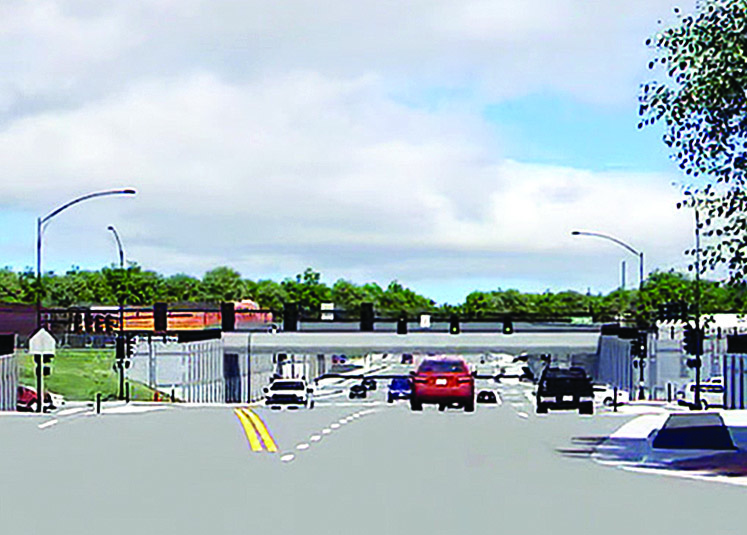 Nancy Edmonds Hanson
Nancy Edmonds Hanson
City leaders are hailing the Minnesota Legislature’s passage last week of a $1.9 billion statewide bonding bill a big deal for Moorhead. Among its key provisions: $62 million in funding for the 11th Street underpass, a solution at last to the near-constant bisecting of the city by passing trains. Also included is $7.5 million to build a new joint Clay County-Moorhead solid waste transfer station on the north side and and $5.34 million for expanding the local National Guard Armory.
“Funding for the underpass opens up a whole window of opportunity we didn’t have before,” Mayor Johnathan Judd says. “This has truly been a team effort by our legislative delegation – Reps. Ben Lien and Paul Marquart and Sen. Kent Eken – along with Dr. Bob Zimmerman, Lisa Bode and their staffs, as well as former Mayor Del Rae Williams and council members past and present. That’s what finally pushed it over the edge.
“We kept on knocking on the door, and it finally opened.”
Adds governmental affairs director Lisa Bode, “It’s pretty awesome. It’s absolutely fantastic. This is a critical project for Moorhead.”
The 11th Street project seeks to counter the persistent problems created by the BNSF rail lines that bisect the city. The KO main line, a double track between Main and Center Avenues, and the Prosper line between Center and First Avenue North carry an average of 70 east- and west-bound trains every day. With average times on the KO line of 3.2 minutes and 4.8 minutes on the northern route plus the four or five minutes it takes for the backed-up traffic to clear the crossing, it adds up to more than five hours of blockage, or 22% of every day.
The underpass is projected to deliver $240 million in the 20 years after its completion, along with other benefits: Prevention of 254 crashes and elimination of 7.2 million hours in delays.
“It’s like having a foreign country run right through the center of the city,” says Downtown Moorhead Inc. president Derrick LaPoint, describing the railroad no-man’s-land that zips down the middle of the area. He adds, “This is going to bring a lot of jobs to build it, along with jobs from increased economic development and the sustainable jobs that come with them.”
City engineer Bob Zimmerman points out that the railroad is the whole reason for the city of Moorhead. Yet persistent problems caused by its passage have bedeviled the city all along. With the police department and main fire station located north of the tracks, public safety is as great an issue as inconvenience and delays. Until the Main/20/21st Street underpass is completed in 2021, the only alternative to delays is Third Street, which runs under Main and Center Avenues to join First Avenue North.
“Getting this money is a huge milestone for the city,” the engineer says. “Conceptual plans for a downtown underpass go back to the 1970s. This is going to be a huge benefit.”
The sixth time was the charm, apparently. After the 2020 Legislature ended without a bonding bill, it came up – and failed – during four consecutive special sessions. Finally bipartisan compromise got it through the fifth special session and onto the governor’s desk. “The prospects were getting dimmer and dimmer,” Zimmerman observes. “We figured this was it. If not now, it wasn’t going to happen this year. Who knows after that?”
He credits the Minnesota Department of Transportation for successfully shepherding the bill throughout the long-drawn-out process. The project has been at the top of its list of priorities at least since 2014, he says.
“MNDOT is the lead agency on the project going forward,” Zimmerman points out. That means the state agency will take it from here, working closely with the city on the next three steps: Completing the environmental review that’s been in the works for several years, finalizing the design phase of the enormous project, and acquiring property along the route. Asked about when actual construction might begin, he shared a “very, very optimistic” estimate of 2023.
Moorhead’s share of the project, he says, is expected to come to about $3 million moving forward. That’s beyond the vast amount of staff preparatory work that’s been done so far, the equivalent of another three-quarters of a million. Zimmerman also points to a substantial investment in acquiring some of the property the interchange will occupy, including the site of the old railside elevators that have been demolished. The city purchased the auto repair shop at 11th and Main several years ago, and will close soon on the former CB Electric at 11th and Center.
Even with state funding finally a “go,” a gap remains between what’s now approved and the project’s estimated total of $85 million. Bode has been working with a coalition of MNDOT and the multi-state Great Northern Coalition to secure a $25 million BILD grant from the federal government. It has failed to be chosen by the U.S. Department of Transportation in the last two rounds of grant awards, but she and Zimmerman remain hopeful that they can learn more in the post-grant debriefing and try again next year.
As the project gets off the ground in coming days, Judd looks forward to more good news to come. “This opens up a window of opportunity we didn’t have before,” he predicts. “It’s going to change what downtown looks like. There are ideas on hold out there just waiting for the underpass to open.”
‘A Window of Opportunity’ for Moorhead


